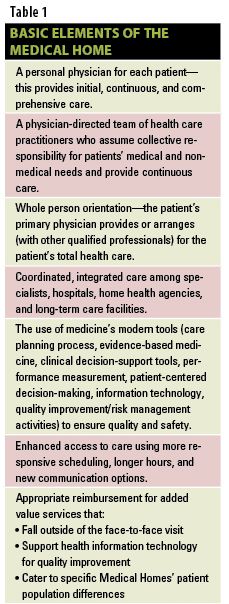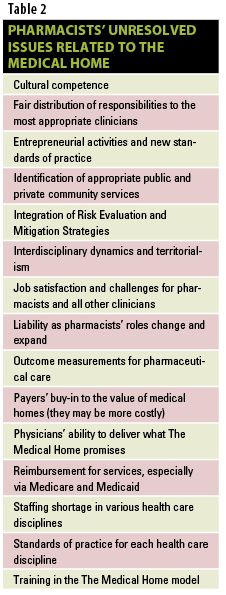Publication
Article
Pharmacy Times
The Medical Home Model
Author(s):
As health care reform brings The Medical Home concept closer to reality, what can pharmacists expect?
As health care reform brings The Medical Home concept closer to reality, what can pharmacists expect?

Health Care Reform (HCR)’s ambitious agenda for the overhaul of health care delivery has created a new vocabulary. One term—The Medical Home (TMH)—refers to one of the most confusing albeit the most promising of changes. It’s confusing because the word “Home” is a noun and implies a place. It sometimes creates a nostalgic picture of the visiting physician caring for a homebound patient surrounded by medical equipment.
TMH is not a place, but rather a theory and model for providing comprehensive primary care. It creates and encourages partnerships between health care providers and individual patients—and sometimes the patient’s significant others. The goal is affordable health care, better access, increased patient satisfaction, and improved health outcomes. In this model, the physician’s office becomes the hub for patient care activities, and patient needs and convenience are stressed. For this reason, it is also called the Patient- Centered Medical Home.1-4 With so many unresolved issues and questions—especially about the

role of the pharmacist— if TMH were a book, we might call it (tongue in cheek) “Increasingly Complex Health Care for Dummies”!
Origins and Elements of The Medical Home
Built on principles developed by the American Academy of Pediatrics (AAP) in 1967, TMH models can differ. Currently, the AAP devotes a Web page (www.medicalhomeinfo.org) to explaining its parameters for a family-centered medical home. Table 1 describes elements associated with TMH.
One area of contention during the extensive HCR debate was the use of a physician- centered model. The Joint Principles of the Patient-Centered Medical Home indicate that consumers in TMH models decide who will be on their team. The primary care physician leads the interdisciplinary effort to meet all of the patient’s needs in an integrated “whole person” fashion.2 Mary Costanza, MD, immediate past president of the National Academies of Practice, says, “Even the name ‘The Medical Home’ implies a physician must lead the team. This is unfortunate at a time when we truly need interdisciplinary care, and in many cases, a different health care professional could lead the team.” For many health care clinicians, it is difficult to envision our time-strapped physician colleagues meeting this mandate. Additionally, our current silo-plagued system is physician-directed. Some health care activists suggest that perhaps the care coordination role should rotate.
What About Pharmacists?
Although the HCR legislation does not specifically mention pharmacists, pharmacists certainly have much to offer the model. Pharmacists have historically been early adopters of medicine’s modern tools to ensure quality and safety. Among these are especially information technology, evidence- based medicine, clinical decisionsupport tools, and quality improvement activities.
Medication therapy management (MTM), medication reconciliation, disease management, and patient education are 4 key areas where pharmacists already partner with patients and other clinicians to improve care.
Recently, the University of Connecticut’s School of Pharmacy Advisory Board (UCONN AB) discussed TMH and pharmacists’ potential roles on the team. In reviewing the school’s need to prepare pharmacists for TMH, discussants voiced many of the same questions and concerns as those of community pharmacists. The fact that the government has not defined a pharmacist role in TMH creates a dilemma (ensuring pharmacists will be involved) as well as an opportunity (the potential to define the specific ways that pharmacists can best help).
Members of the UCONN AB indicated that questions related to how patients will access care and which providers will see patients—and be reimbursed—still loom large. They concurred that TMH relies on mid-level practitioners, creating a need for incentives for young people to enter the health care field. Table 2 lists other potential concerns.

As previously noted, the Joint Principles of the Patient-Centered Medical Home indicate patients will choose their own health care teams.2 TMH’s biggest challenge may be elucidating society’s idea of what “interdisciplinary care” means, and creating models that meet expectations. It is unclear how society sees pharmacists in TMH, and there is a possibility that society as a whole may not understand or appreciate the pharmacist’s abilities and potential. If that is the case, our political advocates, including professional societies, legislators, large and small employers, and patient groups, among others, will need to help educate the public about our value.
Additionally, most pharmacists have unanswered questions about MTM. Admittedly, many pharmacists have been overtrained for their practices for many years, or pressing demands have created barriers to delivering optimal clinical services. Regardless, pharmacists need specific competencies for MTM—competencies that have been unnecessary or gotten rusty in traditional roles. Students also need to be educated about best practices in this area, and so do mid-career pharmacists who may find MTM different and more daunting than the clinical care services they have delivered in the past. The UCONN AB, as well as many practicing pharmacists, also raised questions about liability as practice expands, especially in venues previously handled by physicians.
Becoming Supporters
Despite the unresolved issues associated with TMH, pharmacists need to understand why reformed health care is so important. The Commonwealth Fund’s 2008 National Scorecard on US Health System Performance found that care coordination was rare and that almost half of all Americans reported communication problems with their primary care clinician. They found that only 65% of adults under the age of 65 years had an accessible primary care provider—and only half received all recommended screening and preventive care. Furthermore, among uninsured individuals, only one third had received appropriate preventive care. Among 19 developed countries, the United States now ranks last on a measure of mortality that could have been avoided with appropriate medical care.3 Our need to improve is undeniable.
Conclusion
Effective organizations require 3 things: dynamic leadership, excellent information management, and a performance improvement system. As health care venues across the nation implement TMH, these factors will continue to be important. Increasingly, that dynamic leadership will need to be interdisciplinary in vision.
Information management will need to reduce real and perceived distance among providers, and between providers and patients. As always, the health care community, working together, will need to measure outcomes and strive continuously for improved performance.
Ms. Wick is senior clinical research pharmacist at the National Cancer Institute, National Institutes of Health, Bethesda, Maryland. The views expressed here are those of the author and not necessarily those of any government agency.
References
1. American Academy of Pediatrics. The National Center for Medical Home Implementation. www.medicalhomeinfo.org/. Accessed December 1, 2010.
2. American Academy of Family Physicians (AAFP), American Academy of Pediatrics (AAP), American College of Physicians (ACP), and American Osteopathic Association (AOA). Joint principles of the patient-centered medical home. March 2007. www.medicalhomeinfo.org/downloads/pdfs/jointstatement.pdf. Accessed December 1, 2010.
3. Why not the best? Results from the National Scorecard on U.S. Health System Performance, 2008. www.commonwealthfund.org/Content/Publications/Fund-Reports/2008/Jul/Why-Not-the-Best--Results-from-the-National-Scorecard-on-U-S--Health-System-Performance--2008.aspx. Accessed December 1, 2010.
4. Backer LA.The medical home: an idea whose time has come … again. Fam Pract Manag. www.aafp.org/fpm/2007/0900/p38.html. Accessed December 1, 2010.







